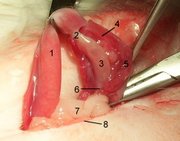

Custom Search
|
Spaying and neutering are the respective processes of female and male animal sterilization, in order to keep them from producing offspring.
Unlike in humans, this usually includes (somewhat controversially) the entire removal of related major organs. While most agree on the advantages of sterilization itself, the necessity of the castration part is even now hotly debated.
The processes are sometimes referred to as castration, due to the removal of organs, although the term in itself specifically refers to the removal of the male testicles.
Most humane societies, animal shelters, and rescue groups urge pet owners to have their pets spayed or neutered to prevent the births of unwanted and accidental litters, contributing to the overpopulation of animals.
In addition, the process has theoretical health benefits (uterine and testicular cancer or similar diseases are definitely ruled out, and hormone-driven diseases such as breast become a non-issue as well), and it may help to address behavioral issues that otherwise can result in animals being given up to shelters, abandoned or euthanised. Obviously, the animals lose their libido, and females no longer experience heat cycles. This is due to the great hormonal changes involved with both genders, and any neutering will definitely cause minor personality changes in the animal.
 Spaying of a female cat.
Spaying of a female cat.
In female animals, spaying involves invasive abdominal surgery to remove the ovaries and uterus, rarely involving major complications. It is commonly practiced on household pets such as cats and dogs as a method of birth control, but is rarely performed on livestock. Possible complications include urinary incontinence and minor weight gain.
A specialized vocabulary in animal husbandry and -fancy has arisen for spayed females of given animal species:
In male animals, neutering involves the removal of the testes, and is commonly practiced on both household pets (for birth control) and on livestock (for birth control, as well as to improve commercial value). It is often recommended in cases of undesirable behavior ( roaming, marking, aggression, and mounting ) in domestic animals, but studies suggest that the behavioral modification effects of surgical castration ... are far from absolute . Additionally, the utility of castration to prevent testicular and prostatic cancer appears to be limited: surgically castrated dogs display a markedly increased incidence of prostatic cancer, and the incidence of malignant testicular cancer in animals is very low.[4]
Neutered males of given animal species also have specific names:
Cats, made by MultiMedia | Free content and software
This guide is licensed under the GNU Free Documentation License. It uses material from the Wikipedia.